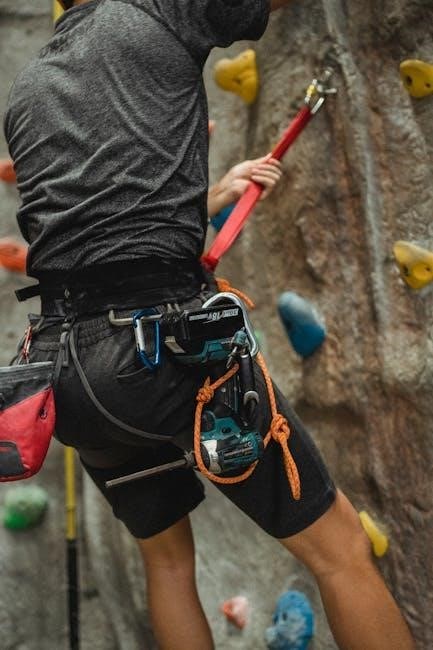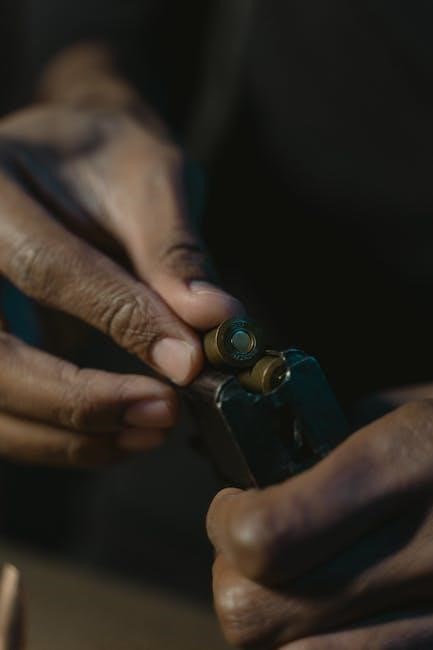The Sig P365X is a popular concealed carry pistol known for its reliability and compact design․ Manual safety in firearms is a critical feature for user control and security․
1․1 Overview of the Sig P365X
The Sig P365X is a compact, lightweight pistol designed for concealed carry and self-defense․ It features a 10-round magazine capacity, a 3․1-inch barrel, and an ergonomic grip for comfortable handling․ Built with a durable stainless steel frame and a Nitron-finished slide, the P365X combines reliability and durability․ Its slim profile makes it ideal for everyday carry, while its intuitive design ensures easy operation․ The pistol is chambered in 9mm Luger, offering manageable recoil and consistent performance․ With its focus on safety and functionality, the P365X has become a popular choice among firearms enthusiasts and professionals alike, blending modern engineering with practical features for real-world applications․
1․2 Importance of Manual Safety in Firearms
The manual safety mechanism in firearms plays a crucial role in preventing accidental discharges, ensuring user control, and enhancing overall safety․ It provides an additional layer of protection, especially in high-stress situations, by physically blocking the firearm’s action․ This feature is particularly valued by users who prioritize intentional engagement, as it reduces the risk of unintended discharge․ For concealed carry firearms like the Sig P365X, manual safety can offer peace of mind, knowing the weapon is secured when not actively in use․ However, its effectiveness largely depends on proper training and consistent use, as it requires deliberate action to engage or disengage․ Balancing convenience and safety, manual safety remains a key consideration in firearm design and user preference․

History of the Sig P365X
The Sig P365X was introduced in 2019, building on the success of the original P365․ It quickly gained fame for its compact size and high capacity․
2․1 Development and Release of the P365X
The Sig P365X was developed as an expansion of the original P365 platform, introduced in 2019․ It was designed to meet the growing demand for concealed carry firearms that combine reliability, accuracy, and capacity․ The P365X features a 3․1-inch barrel, a 10-round flush-fit magazine, and an optional 12-round extended magazine․ Its striker-fired design and modular construction set it apart from earlier models․ The pistol was well-received for its ergonomic design and versatility, appealing to both civilian shooters and law enforcement professionals․ The release of the P365X solidified Sig Sauer’s position in the competitive compact pistol market, offering a balance of performance and practicality․
2․2 Popularity and Market Reception
The Sig P365X gained significant popularity shortly after its release, becoming a favorite among concealed carry enthusiasts․ Its sleek design, high capacity, and reliability resonated with shooters․ The market embraced it for its versatility, appealing to both law enforcement and civilian users․ The absence of a manual safety was initially controversial but ultimately accepted by many who appreciated the streamlined design․ Some critics argued that the lack of a manual safety could pose risks, while others praised its simplicity and ease of use․ Despite debates, the P365X remains a top choice in the concealed carry market, supported by a wide range of aftermarket accessories․

Understanding Manual Safety Mechanisms
Manual safety mechanisms are physical components that prevent accidental discharges․ They function by interrupting the firing process, requiring intentional engagement for the firearm to discharge safely․
3․1 What is a Manual Safety?
A manual safety is a mechanical feature on firearms designed to prevent accidental discharge․ It is typically a lever, button, or switch that, when engaged, blocks the firearm’s action, ensuring it cannot fire․ This mechanism provides an additional layer of control, allowing the user to consciously decide when the weapon is ready to discharge․ Manual safeties are commonly found on handguns, rifles, and shotguns, varying in design depending on the firearm type․ They serve as a critical component in firearm safety, reducing the risk of unintended activation․ By requiring deliberate action to disengage, manual safeties enhance user control and confidence, especially in high-stress situations․
3․2 How Manual Safety Works in Firearms
A manual safety is a physical mechanism designed to prevent a firearm from discharging unintentionally․ It typically operates by blocking the trigger, hammer, or firing pin when engaged․ In most firearms, the safety is a lever or button located on the slide or frame․ When activated, it interrupts the firing sequence, ensuring the gun cannot fire even if the trigger is pulled․ Many safeties also lock the slide or prevent the striker from moving․ Proper use requires deliberate engagement and disengagement, ensuring the firearm is only operational when intended․ While not a substitute for safe handling, a manual safety adds an extra layer of control, reducing accidental discharges․ Understanding its operation is essential for responsible firearm ownership․

The Sig P365X Manual Safety
The Sig P365X features an optional manual safety, allowing users to choose between a standard or manual safety version․ This design choice reflects modern concealed carry preferences․
4․1 Does the P365X Have a Manual Safety?
The Sig P365X does not feature a manual safety․ Designed for concealed carry, it relies on a trigger safety mechanism to prevent accidental discharges․ This design choice aligns with modern trends favoring sleek, snag-free firearms for self-defense․ The absence of a manual safety reduces complexity and potential points of failure, making the pistol more intuitive for users․ However, this has sparked debate among shooters who prefer the added layer of control a manual safety provides․ SIG Sauer’s decision reflects a focus on reliability and ease of use, catering to a market prioritizing simplicity and safety through modern engineering․
4;2 Reasons for the Absence of a Manual Safety
The Sig P365X does not feature a manual safety, a design choice influenced by modern trends in concealed carry pistols․ Reliability is a key factor, as manual safeties can complicate the draw process․ The absence of a manual safety streamlines operation, reducing the risk of accidental disengagement or failure to disengage under stress․ Additionally, the P365X incorporates passive safety mechanisms, such as a trigger safety, to prevent unintended discharges․ This design aligns with the preference of many shooters who prioritize simplicity and ease of use․ While this may not suit all users, it reflects a broader industry shift toward streamlined, user-friendly firearms․ The P365X’s design emphasizes reliability and intuition, catering to both experienced shooters and newcomers․

Pros and Cons of Manual Safety
Manual safety offers an additional layer of security, preventing accidental discharges, but can add complexity and require deliberate action, which may not suit all users․
5․1 Advantages of Manual Safety
A manual safety provides an additional layer of security, offering users physical control over the firearm’s discharge․ It prevents accidental firings, especially in stressful situations, by requiring intentional disengagement․ This feature reassures users, as it provides both visual and tactile confirmation that the weapon is safe․ Manual safeties also allow for quick action once disengaged, making them practical for self-defense scenarios․ Furthermore, they promote disciplined handling habits, as users must intentionally manipulate the safety, reducing the risk of negligent discharges․ For many shooters, the presence of a manual safety enhances their sense of control and confidence when carrying or using the firearm․
5․2 Disadvantages of Manual Safety
Manual safety mechanisms can introduce potential points of failure, as they rely on user interaction․ If the safety is not disengaged properly, it can prevent the firearm from firing when needed, potentially leading to dangerous situations․
The added complexity of a manual safety can also increase the likelihood of mechanical issues, especially if the mechanism is not designed or maintained correctly․ This can compromise the overall reliability of the firearm․
Additionally, manual safeties can be a hindrance in high-stress situations, where split-second decisions are critical․ Users may forget to disengage the safety, leading to delays or failure to respond effectively․
Moreover, the presence of a manual safety requires additional training and practice to ensure proper operation, which can be a disadvantage for inexperienced shooters․
Finally, some argue that manual safeties can create a false sense of security, leading to complacency in following other essential safety protocols․

Alternative Safety Features in the P365X
The P365X incorporates a trigger safety mechanism to prevent accidental discharge․ Additionally, it features passive safety elements like a firing pin block for enhanced security without manual intervention․
6․1 Trigger Safety Mechanism
The Sig P365X features a trigger safety mechanism designed to prevent accidental discharges․ This system ensures the firearm only fires when the trigger is intentionally pressed․ Unlike a manual safety, the trigger safety is integrated into the trigger itself, eliminating the need for a separate lever․ When the trigger is partially pressed or jarred, the mechanism blocks the firing pin from striking the primer․ This passive safety feature is highly effective and reduces the risk of unintentional discharge․ It appeals to users who prefer a sleek, snag-free design without compromising safety․ The trigger safety works seamlessly with the P365X’s striker-fired system, providing an additional layer of security without requiring manual activation․
6․2 Other Passive Safety Features
The Sig P365X incorporates additional passive safety mechanisms to enhance user security․ These include a firing pin block that prevents unintended discharge without the trigger being pulled․ The pistol also features a drop safety design, ensuring it won’t fire if accidentally dropped․ Its striker-fired system is engineered to reduce the risk of accidental ignition․ Additionally, the P365X’s ergonomic design promotes a firm grip, minimizing the chance of involuntary trigger pull․ These features collectively provide a robust safety profile, compensating for the absence of a manual safety lever․ They ensure the firearm operates safely under various conditions, giving users confidence in its reliability and performance․

User Perspectives on Manual Safety
Users have mixed opinions on manual safety, with some preferring the added security layer and others finding it redundant on modern pistols like the P365X․
7․1 Pro-Manual Safety Arguments
Proponents of manual safety argue that it provides an additional layer of security against accidental discharges, especially in high-stress situations․ A manual safety can act as a deliberate step to ensure the firearm is ready to fire, reducing the risk of unintended activation․ Many shooters appreciate the tactile confirmation that the safety offers, reinforcing safe handling habits․ For those trained to rely on manual safeties, it becomes second nature, enhancing their confidence and control․ Critics of its absence, like in the P365X, often cite the lack of this mechanical backup as a potential liability, particularly in environments where the firearm might be handled by multiple users or in unpredictable conditions․
7․2 Anti-Manual Safety Arguments
Some argue that manual safeties can hinder quick access in high-stress situations, potentially delaying defensive actions․ Others believe they add unnecessary complexity, as modern firearms often rely on trigger safeties and proper handling․ Additionally, critics suggest that manual safeties can be accidentally disengaged or forgotten, leading to unintended discharges․ Some shooters find manual safeties uncomfortable or obstructive, especially with certain grip styles․ Finally, the reliance on a manual safety can lead to complacency, discouraging users from following other critical safety protocols; These arguments emphasize practicality and simplicity, advocating for firearms designed with passive safety features over manual controls․

Maintenance and Care of the P365X
Regular cleaning and lubrication of the P365X ensure optimal performance․ Proper storage in a safe or dry place prevents rust and accidental discharge․
8․1 Cleaning and Lubrication
Cleaning and lubricating the Sig P365X is essential for maintaining its performance and reliability․ Start by field-stripping the pistol, removing the slide and barrel from the frame․ Use a soft brush and solvent to remove residue from the barrel, chamber, and slide rails․ Wipe down all surfaces with a clean, lint-free cloth․ Apply a high-quality firearms lubricant to moving parts, such as the barrel hood, slide rails, and trigger mechanism․ Avoid over-lubrication, as excess can attract debris․ Regular maintenance ensures smooth operation and prevents corrosion․ Always use products designed for firearms to maintain durability and functionality․ Proper care extends the lifespan of your P365X and ensures consistent reliability․
8․2 Storage and Handling Best Practices
Proper storage and handling of the Sig P365X are essential for safety and longevity․ Always store the firearm unloaded in a secure, locked container or safe to prevent unauthorized access․ Use a high-quality holster designed for the P365X when carrying to ensure secure retention and avoid accidental discharge․ Keep ammunition stored separately in a cool, dry place․ Regularly inspect the firearm and holster for wear and tear․ Avoid exposing the P365X to extreme temperatures or humidity, as this can affect its performance․ Always handle the firearm with care, ensuring your finger is off the trigger until ready to shoot․ Store the pistol in a location inaccessible to children or individuals not trained in firearm safety․ Follow local laws and regulations for firearm storage․ Regular maintenance and inspection are crucial for optimal functionality․
Training and Safety Protocols
Proper training is essential for Sig P365X owners․ This includes safe handling practices, understanding the decocker function, and mastering proper techniques to prevent accidental discharge․
9․1 Recommended Training for P365X Owners
Proper training is essential for Sig P365X owners to ensure safe and effective use․ Begin with basic firearm safety protocols, such as always treating the gun as loaded and keeping fingers off the trigger until ready to shoot․ Practice proper gripping, sighting, and trigger control to maintain accuracy․ Engage in regular live-fire exercises to build muscle memory and confidence․ Additionally, consider scenario-based training to prepare for real-world self-defense situations․ Understanding the P365X’s mechanics, including its trigger system and safety features, is also crucial․ Finally, enroll in certified firearm courses to reinforce best practices and stay updated on legal and ethical considerations for concealed carry․
9․2 Safe Handling Practices
Safe handling practices are essential to ensure the secure operation of the Sig P365X․ Always treat the firearm as loaded, keeping the muzzle pointed in a safe direction; Before handling, verify the area is clear of obstacles and bystanders․ Maintain a firm, consistent grip and avoid placing fingers on the trigger until ready to shoot․ Regularly inspect the weapon for proper function and cleanliness․ Use the trigger safety mechanism effectively, as it is designed to prevent accidental discharges․ When loading or unloading, follow established protocols to minimize risks․ Store the P365X in a secure location, out of reach of unauthorized individuals․ Consistent adherence to these practices reduces the likelihood of accidents and promotes responsible firearm ownership․

Legal Implications of Manual Safety
Laws and regulations regarding manual safety vary by jurisdiction, impacting the design and use of firearms like the Sig P365X, with implications for manufacturer and user liability․
10;1 Laws and Regulations Regarding Manual Safety
Laws and regulations regarding manual safety vary by jurisdiction, influencing firearm design and ownership․ In the U;S․, some states require handguns to include manual safeties, while others do not․ The Sig P365X, lacking a manual safety, complies with states that emphasize trigger-based safety mechanisms․ Federal regulations focus on firearm functionality and safety standards, ensuring weapons like the P365X meet rigorous testing․ Owners must familiarize themselves with local laws to ensure compliance․ While the P365X’s design aligns with modern safety trends, legal requirements for manual safeties remain a topic of debate among lawmakers and gun enthusiasts․
10․2 Liability and Responsibility
Liability and responsibility are critical considerations in firearm ownership, particularly regarding manual safety mechanisms․ Firearm manufacturers must ensure their products meet safety standards to avoid legal consequences․ Owners and users bear the responsibility of adhering to safety protocols, proper training, and secure storage to prevent accidents․ Misuse or negligence can lead to legal repercussions, emphasizing the importance of understanding and following safety guidelines․ The absence of a manual safety on the Sig P365X shifts the burden of responsibility to the user, highlighting the need for diligent handling and adherence to best practices․ Ultimately, liability and responsibility underscore the importance of education and awareness in firearm ownership․
FAQs About the P365X Manual Safety
Frequently Asked Questions about the Sig P365X manual safety often focus on its absence, reasons behind the design choice, and reliance on trigger safety mechanisms instead․
11․1 Common Questions from Users
Users often inquire about the absence of a manual safety on the Sig P365X, questioning its reliability without this feature; Many ask if the pistol can be safely carried without a manual safety and how to handle it responsibly․ Others seek clarification on whether aftermarket manual safeties are available or recommended․ Additionally, some users wonder if the lack of a manual safety affects the pistol’s legal classification or suitability for concealed carry․ These questions reflect concerns about safety, functionality, and compliance, highlighting the importance of understanding the P365X’s design philosophy and integrated safety mechanisms․
11․2 Expert Answers and Clarifications
Experts clarify that the Sig P365X does not include a manual safety, relying instead on a trigger safety mechanism․ This design choice aligns with modern concealed carry trends, prioritizing simplicity and reducing snag risks․ Professionals emphasize that the absence of a manual safety does not compromise safety when proper handling and training are applied․ They recommend focusing on consistent training and adherence to safe practices․ Additionally, experts highlight the importance of understanding the firearm’s design and mechanisms to ensure responsible ownership and use․
- Q: Is the P365X safe without a manual safety?
A: Yes, when used correctly, as it features a trigger safety and other passive mechanisms․ - Q: Should I rely solely on the trigger safety?
A: No, combine it with proper handling and holstering practices for maximum security․
Understanding these aspects ensures confidence in the P365X’s safety features․
The Sig P365X balances functionality and safety, sparking debates on manual safety’s role in modern firearms․ Its design reflects a focus on concealability and user preference․
12․1 Summary of Key Points
The Sig P365X is a compact, reliable firearm designed for concealed carry, sparking debates about manual safety․ It lacks a manual safety, relying on a trigger safety and passive mechanisms․ Proponents argue manual safeties provide control, while opponents see them as unnecessary with modern designs․ User perspectives vary, with some valuing the extra layer of security and others preferring simplicity․ Legal and liability considerations highlight the importance of proper usage and training․ Maintenance and safe handling are crucial for reliability․ The P365X represents a shift toward streamlined, intuitive designs, reflecting broader industry trends in safety technology and user responsibility․ Balancing safety, functionality, and user preference remains central to its design philosophy․
12․2 Final Thoughts on Manual Safety in the P365X
The Sig P365X sparks debate due to its lack of a manual safety, yet its reliability and safety features make it a trusted choice for concealed carry․ While some users prefer the tactile reassurance of a manual safety, the P365X’s design emphasizes passive safety mechanisms, such as its trigger system, to prevent accidental discharges․ Ultimately, whether the absence of a manual safety is a drawback depends on personal preference and training․ Responsible gun ownership, regardless of the firearm’s design, remains paramount․ The P365X proves that modern pistols can be both safe and user-friendly without a manual safety, catering to a growing market that prioritizes simplicity and reliability․

Future Trends in Firearm Safety
Future firearm safety may include advanced trigger systems, biometric safeties, and AI-driven lockouts, enhancing security without compromising functionality for users like the Sig P365X․
13․1 Advancements in Safety Technology
Recent advancements in safety technology have revolutionized firearm design, particularly in pistols like the Sig P365X․ Innovations such as smart gun technology, which uses biometric authentication to ensure only authorized users can fire the weapon, are gaining traction․ Modular safety systems now allow users to customize safety features based on their preferences․ Additionally, trigger safety mechanisms have become more sophisticated, reducing the risk of accidental discharges․ The integration of wearable devices and AI-driven monitoring systems further enhances safety by providing real-time feedback․ These technologies not only improve reliability but also cater to modern shooters’ diverse needs, ensuring firearms remain safe and user-friendly․
13․2 Industry Shifts in Safety Design
The firearm industry is evolving toward safer, user-friendly designs, with many manufacturers adopting striker-fired pistols without manual safeties, like the Sig P365X․ This shift reflects modern concealed carry preferences, prioritizing simplicity and ease of use․ Companies are integrating trigger safeties and passive mechanisms to prevent accidental discharges, reducing reliance on manual controls․ These designs cater to a growing market of self-defense shooters who value intuitive operation․ Additionally, advancements in materials and ergonomics are enhancing safety without compromising functionality․ The industry is also seeing a rise in redundant safety systems, ensuring firearms function safely even without manual intervention․ This trend highlights a broader movement toward streamlined, reliable safety solutions that align with contemporary shooter needs and preferences;
